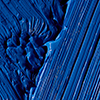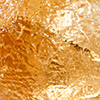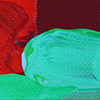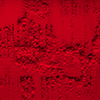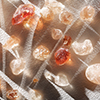Rules for Permanent Painting
Underpainting
Oil paints which are slow driers should be avoided in underpainting because the underlayers will remain mobile and move as they dry.
This causes cracking of the fast drying colours which may be used on top of them.
Pigments to avoid in underpainting: Cadmiums, Ivory and Lamp Black, Zinc White, Arylide Yellow.
To help the application of colours when underpainting the colours are often thinned to a more fluid consistency. Avoid using only a solvent as this often leads to underbound oil paint that will crack or dust off.
The use of oil mediums for general painting
The use of mediums for facilitating different textural or spatial effects, ease of application and for the permanence of the artwork has a long and often dubious history. Materials available to the modern artist are of greater quality and permanence than those available to artists prior to this century. The use of certain archaic mediums, from the point of view of stability, are of historical interest only. The use of the smallest amount of medium is always desired as all permanent mediums contain percentages of drying oil, normally Linseed, Stand or Safflower. It is the oil that will yellow or darken with age thereby discolouring the artwork, therefore the use of a non-yellowing oil such as Stand Oil is desired.
Langridge Underpainting Medium, Painting Medium, Glaze Medium and Wax Painting Paste use Stand Oil as their base. Stand Oil is manufactured through heating Linseed Oil to 575 degrees Fahrenheit in absence of oxygen for several hours. Through this process the Linseed Oil polymerises and creates a heavy viscous material with non-yellowing properties.
Apply the underpainting or ‘first sketch’ with Underpainting Medium, a lean medium that allows the artist to confidently apply colours that will dry rapidly, yet not sink-in and dull off. Next use either Painting Medium or Glaze Medium. With Painting Medium the artist can improve the flow of oil colours and is especially useful for working on paintings in one or two sessions. It has a pronounced ‘grab’ when still wet and is perfect for a wet-into-wet technique. Alternatively, Glaze Medium should be used when creating spatial effects allowing subtle alterations of the existing passages of paint. It will tend to make the paint more transparent so that gentle gradations of light and shade can be achieved.
Wax Painting Paste is added to oil paint to give extra bulk without loss of opacity. It tends to give a matt surface as the refined beeswax content has a matting effect when used in sufficient quantities. It is advisable to use this wax medium for impasto work rather than the use of gelled oil mediums as these have a tendency for dramatic yellowing and surface crawl.
Varnishing
An oil painting should be allowed to fully dry for at least six months before final varnishing. A picture varnish creates a complete resin coating that protects the painting underneath. However, oil paint needs to absorb oxygen to fully dry and this is why a final picture varnish cannot be applied immediately.
The thicker the paint, the longer the drying time. If you wish to give temporary protection to the paint surface the application of Retouch Varnish is recommended. Picture varnishes should have the ability to be easily removed at any future time, once the varnish is dirty and needs to be replaced.
Oil based varnishes cannot be easily removed without the likelyhood of damag- ing the picture so are not recommended as a Picture Varnish.
